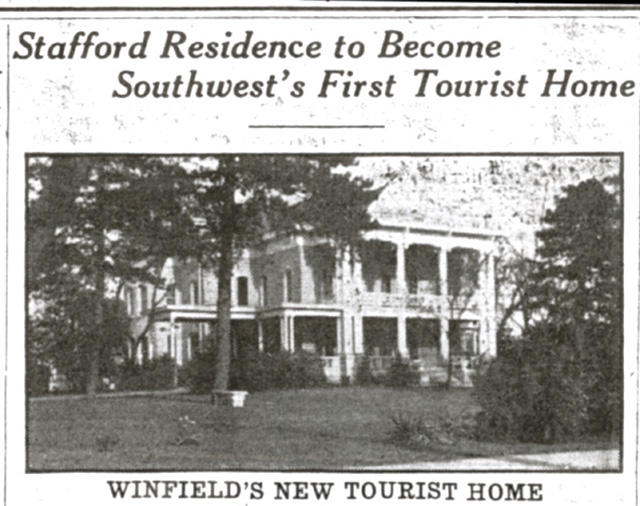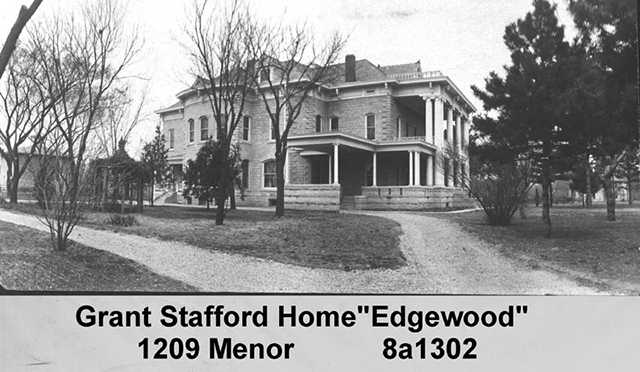








Stafford Residence to Become Southwest's First Tourist Home

WINFIELD'S NEW TOURIST HOME
We are looking for the date of this article from the Winfield Courier. The two clues I see are the neon lights and the opening of the Wilson Oil Field. In a sketchy article from "The Oil Weekly" dated Oct. 21, 1922, I see: "a second well is being drilled in the "Wilson fee in the NWe SW SE 36-23-5. This well is a mile north of the first well and a half mile east. It is now below 2200 feet drilling." This is also a good date for increasing interest in neon lights and would suggest that they would be worth mentioning in a news article in 1922.
Winfield's most palatial home, which at one time blazed with lights as the center of social activity of the city, will once more take its rightful position as one of the show places of the town.
Announcement was made this week by the owner, C. R. Strong, that he would establish a tourist home, one of the latest ideas for accommodation of the traveling public, at the old Stafford home, 1208 Menor, The tourist home idea is popular on the East and West coasts where mansions, now too large for most families, are being used for tourist accommodations.
The idea is new in this section of the country, but Mr. Strong is enthusiastic over the prospect for he says there is no more spacious or elaborately furnished home in Kansas than the Stafford residence. He will cater to the better class of tourist trade which wants fine quarters an service, a quiet and restful place at reasonable prices.
In accordance with his reputation in the past for doing nothing halfway, but to put things over successfully, Mr. Strong is advertising the tourist home over a wide territory. For 100 to 150 miles in every direction on main highways from Winfield Mr. Strong will erect signs advertising the home -And Winfield. He expects to make Winfield known as the site of the tourist home, and to offer such service that travelers will come miles out of their way to stop at the home.
20 Guest rooms
Mr. Strong is a town-builder and promoter and he expects to give Winfield something that no other city in this section of the country can offer. There will be approximately 20 large rooms available for guests, each of them furnished with the rare and costly furniture and equipment for which the home was noted years ago.
Final touches of the necessary remodeling are being done at the present time. The last of the bathrooms is being installed, the driveway is being widened and the parking quarters and a six-stall garage will soon go up un the southeast corner of the block.
So far as possible, Mr. Strong is preserving the natural beauty of the home. The exterior two-foot-think stone walls remain unaltered but all the wood and metal trim has been repainted white. The hand decorated walls in most of the interior are as good as new and will be left as they are. Few partitions have been changed and those only for the installation of the bathrooms, most of which go in the roomy closets without being cramped. Where necessary for convenience, the new lighting equipment has been installed, but so far as possible the old ornate fixtures remain to add their romantic atmosphere.
Mr. Strong is a genial host and enjoys showing guests through the home. It was too large to ever be used for a home again, he explains, so rather than see the fine old place and its furnishings go to waste he decided to turn it in to a useful purpose.
Much Beautiful Furniture
From the two-story Colonial portico facing the east, the guest enters the double doorway into a large center hall, itself a large room. Its center is a rotunda extending to the top of the third floor where a beautiful leaded, stained-glass skylight in oval shape forms the top. At the west end is the staircase to the second floor, with a railing around the rotunda.
The lover of the beautiful and rare in antiques can linger in the house for hours, for in every room is fine furniture, some of walnut, some of mahogany, some in oak, and there are numerous fireplaces, some of fine old walnut, some of native stone , some of black marble.
To the south of the entrance is the room which will be the office. All its wood work and the fireplace mantle are of beautiful sycamore wood, and so far as is know, it is the only room anywhere with this wood.
The second room on the south is the largest living room and across the hall on the north are two "reception rooms," full as large as the living room in an ordinary home. These will be left with their living room furnishings, but can be converted into sleeping quarters if necessary.
Included among the furnishings are the valuable tapestries and paintings which have hung there for years, in addition to some pieces of Mr. Strong's own art collection. The floors are covered with think carpets and new deep carpeting is being laid on the stairway and the upstairs halls.
The rooms are so connected that part of the rooms cam thrown together as suites consisting of living room, bedroom and bath, or can be rented as separate rooms. In all there will be 20 rooms for accommodations of guests, exclusive of quarters for the managers.
A Walnut Dining Room
Back of the main living room is the walnut dining room, 20 by 38 feet, where guests will be served meals at reasonable prices. Back of that is the breakfast room, which is more than ordinary dining room size, then the large kitchen which has been equipped with all kinds of modern devices, and off of that a huge pantry. In the northwest corner is a large suite now occupied by Mr. and Mrs. Strong.
All rooms are steam heated and are cool in summer because of the high ceilings and the thick stone walls. A bull basement is under the house and Mr. Strong expects to work it over into rooms in the future.
The guests will have the use of the wide portico around the front, and may stroll around the block of grounds beautifully planted with flowers, shrubs and shaded by massive old trees. There will be seats near the pond where Mr. Strong has several hundred goldfish as a special hoppy.
If the project works out as Mr.. Strong expects it to, he will construct a row of deluxe cottages along the west side of the block in order to accommodate those who would prefer separate quarters from the home.
Sign will direct the tourist to the location and across the front will be a two-inch strip of green neon, and between the tow center pillars on the second floor will be a neon sign, "Tourist Home."
Mr. Strong is empathetic in stating that he does no intend to compete with any local businesses, the hotels or the restaurants. His idea is to bring new trade to Winfield by drawing travelers here who otherwise might not even pass through the city.
Not a Hotel
He is also emphatic in sating that this establishment is not to he known as a hotel. "It is a tourist home," he declares, "and it will resemble 'home' just as much as possible. It will be quiet with little confusion and noise, and there will be no bellboys or elevators. It will be a dignified establishment catering to the tourist who wants this type of accommodations."
The home will be leased to parties yet to be named by Mr. Strong, but he will retain a controlling interest. He and Mrs. Strong expect to return to their home in Clinton, Okla., after the project gets underway, which will be before Thanksgiving.
Mr. Strong likes Winfield and has a kindly feeling towards it in his heart. It is his "home town" and it was here he got his first start. Sin that time he has dealt in a large way with Oklahoma real estate and residential building projects. In addition to the Stafford home, Mr. Strong owns several Cowley County farms, and has large lease holdings in the newly opened Wilson oil field.
This house was originally built by M. L. Read, the proprietor of Read's Bank. This was the second bank in Winfield, but the first brick structure. An article in the Winfield Courier in 1885 stated that this house was the fine residence of Mr. Read's nephew Mart Robinson. Mr. Read's funeral was Oct. 3, 1892. I think that Mart Robinson died in 1888 or '89. There was, I think, another residence on the block that was occupied by Will Robinson, brother of Mart and nephew of M. L. Read. Will Robinson went on to become the president of the First National Bank of Winfield after a series of mergers and acquisitions. Here is a photo of Will Robinson as a grey headed senior citizen, leaning against the tellers cage at the 40th Anniversary of the opening of his uncle's bank in Winfield with the largest safe ever brought to southern Kansas.

